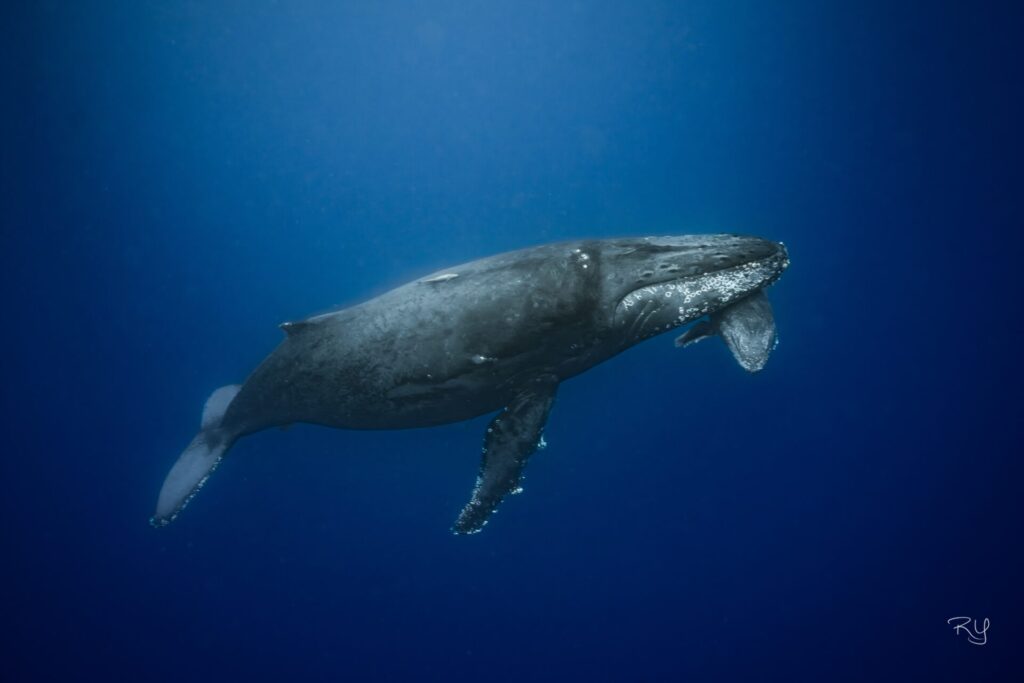What to expect
From February to March, you can observe humpback whales in the waters of Okinawa. They migrate from the north to the warmer seas around Okinawa Island for birthing, nurturing their young, and mating, spending a few months there. The western side of Okinawa Island, with its relatively shallow waters, is particularly suitable for nurturing their young.
Unlike whale watching, this whale swimming activity allows observation from the surface. To minimize stress on the whales, there is a limit of three approaches to the same whale per day. This limit applies to all boats conducting whale swims.
The opportunity to swim with whales is rare and unforgettable, making it a valuable experience.
Whale swim Schedule on calendar
Event Duration
February 1 to February 28, Minimum number of participants: Two (maximum: 15)
Feel free to contact us for alternative dates or if you have any preferences.
Whale swimming activities are for watching from the surface, so skin diving isn’t allowed. We shouldn’t chase or go away from the group to keep the whales calm. We try hard to give you an amazing experience while following these rules. Please read the Whale Swim Participation Guidelines before joining. Also, we can’t promise you’ll see whales every time. Sometimes, nature doesn’t cooperate, and we may not go into the sea at all. Thanks for understanding.
Participation Requirements
Must hold one of the following certifications or equivalent
- Scuba diving open water license+
- Free-diving license
- Skin Diver License

| OPTIONS | |
|---|---|
| Whale swimming | 25,000 |
| Whale whatching | 19,000 |
| Pick up | 6:00-7:00 |
| Meeting time at Migusuku port (Naha) or Toya port (Zanpa) | 7:30 |
| Departure time | 8:30( as soon as ready) |
| Lunch time * recommend having light snacks that allow you to enter the sea immediately upon discovering whales so that you can stop eating at any time. | 12:30 |
| Returning to port | 3:00-3:30 |
11 days before … 0%
10 day before … 100%
*None in case of poor sea conditions.
The cancellation policy for the Whale Swim excursion is as follows: There is no charge for cancellations made up to 11 days prior to the event. However, a 100% cancellation fee applies for cancellations made within 10 days of the event.
(Please read carefully)
On Participation and Boarding:
- To avoid causing too much stress to the humpback whales, there will be a maximum of three approaches to whale parents and calves.
- Individuals without a scuba diving license cannot participate in this course.
- Participants must be able to independently put on and take off fins, mask, and snorkel.
- In case of sudden adverse weather conditions or injuries during the tour, the tour may be canceled, and the boat may return to port.
- Scuba diving with diving equipment is not allowed.
- The use of long fins is prohibited.
- A pre-departure safety briefing will be conducted by staff, so please pay close attention.
During Observation:
- Be cautious not to drop cameras into the deep water, as retrieval may not be possible.
- Do not extend the GoPro stick.
- Avoid chasing whales that have swum past.
- Do not position yourself behind the whale; there is a possibility of being struck by the tail fin.
- Stay away from whales displaying surface agitation.
- If a whale comes close, slowly move away.
- If a whale surfaces for breathing, ensure not to position directly above it.
- Even if a whale comes within touching distance, refrain from touching it, as the barnacles on its body may cause injury.
General Tips:
- Based on experience, non-swimmers have a higher chance of calmly observing whales.
- Resist the temptation to swim; remaining afloat is best!
- If whales show interest, they may approach repeatedly.
Upon Boarding and After:
- Board the boat if whales are no longer visible. While ascending, raise your face to the surface to check the boat’s position.
- Follow the guide in a single line while ascending.
- Boarding methods may vary based on sea conditions, so follow staff instructions.
- Be cautious not to drop your camera when grabbing ropes or ladders.
- Wait until the person in front confirms boarding before climbing the ladder.
- Secure your personal belongings upon boarding, and be ready for potential rapid re-entry into the water.
Cooperation Requested from Everyone:
Whales are wild animals, and encountering them is not guaranteed.Due to whale behavior and sea conditions, swimming may be abandoned, and the activity may switch to whale watching.The first step is to search for whales collectively.While staff members are actively searching, it may take several hours to locate them.Occasionally, a full day may pass without sighting whales.Even when whales are found, if swimming is deemed risky due to whale behavior or sea conditions, the activity may be abandoned.
We strive to provide you with the best encounter with whales and ensure everyone has an enjoyable time. We appreciate your understanding and cooperation.

